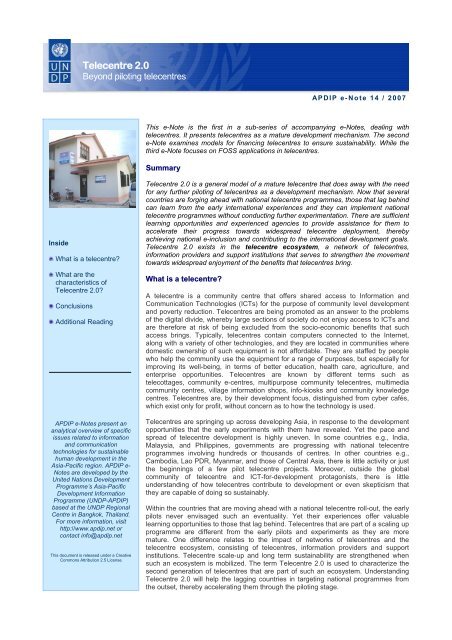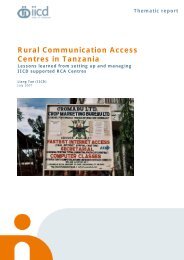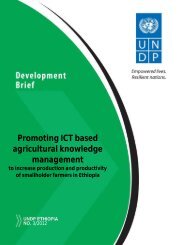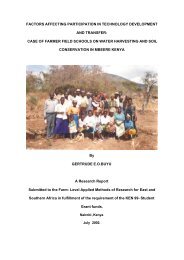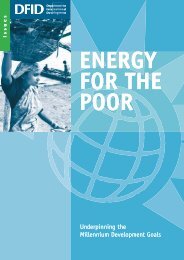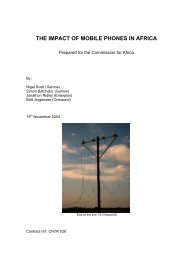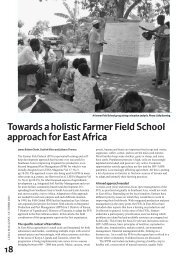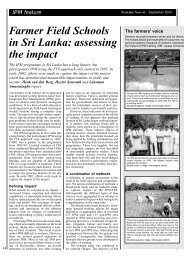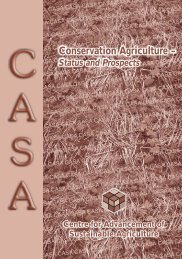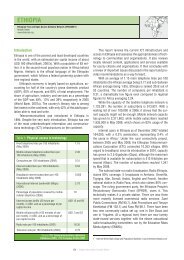Instructions for Formatting Papers - Share4Dev.info
Instructions for Formatting Papers - Share4Dev.info
Instructions for Formatting Papers - Share4Dev.info
Create successful ePaper yourself
Turn your PDF publications into a flip-book with our unique Google optimized e-Paper software.
Telecentre 2.0<br />
Beyond piloting telecentres<br />
APDIP e-Note 14 / 2007<br />
This e-Note is the first in a sub-series of accompanying e-Notes, dealing with<br />
telecentres. It presents telecentres as a mature development mechanism. The second<br />
e-Note examines models <strong>for</strong> financing telecentres to ensure sustainability. While the<br />
third e-Note focuses on FOSS applications in telecentres.<br />
Summary<br />
Inside<br />
What is a telecentre?<br />
What are the<br />
characteristics of<br />
Telecentre 2.0?<br />
Conclusions<br />
Additional Reading<br />
APDIP e-Notes present an<br />
analytical overview of specific<br />
issues related to in<strong>for</strong>mation<br />
and communication<br />
technologies <strong>for</strong> sustainable<br />
human development in the<br />
Asia-Pacific region. APDIP e-<br />
Notes are developed by the<br />
United Nations Development<br />
Programme’s Asia-Pacific<br />
Development In<strong>for</strong>mation<br />
Programme (UNDP-APDIP)<br />
based at the UNDP Regional<br />
Centre in Bangkok, Thailand.<br />
For more in<strong>for</strong>mation, visit<br />
http://www.apdip.net or<br />
contact <strong>info</strong>@apdip.net<br />
This document is released under a Creative<br />
Commons Attribution 2.5 License<br />
Telecentre 2.0 is a general model of a mature telecentre that does away with the need<br />
<strong>for</strong> any further piloting of telecentres as a development mechanism. Now that several<br />
countries are <strong>for</strong>ging ahead with national telecentre programmes, those that lag behind<br />
can learn from the early international experiences and they can implement national<br />
telecentre programmes without conducting further experimentation. There are sufficient<br />
learning opportunities and experienced agencies to provide assistance <strong>for</strong> them to<br />
accelerate their progress towards widespread telecentre deployment, thereby<br />
achieving national e-inclusion and contributing to the international development goals.<br />
Telecentre 2.0 exists in the telecentre ecosystem, a network of telecentres,<br />
in<strong>for</strong>mation providers and support institutions that serves to strengthen the movement<br />
towards widespread enjoyment of the benefits that telecentres bring.<br />
What is a telecentre?<br />
A telecentre is a community centre that offers shared access to In<strong>for</strong>mation and<br />
Communication Technologies (ICTs) <strong>for</strong> the purpose of community level development<br />
and poverty reduction. Telecentres are being promoted as an answer to the problems<br />
of the digital divide, whereby large sections of society do not enjoy access to ICTs and<br />
are there<strong>for</strong>e at risk of being excluded from the socio-economic benefits that such<br />
access brings. Typically, telecentres contain computers connected to the Internet,<br />
along with a variety of other technologies, and they are located in communities where<br />
domestic ownership of such equipment is not af<strong>for</strong>dable. They are staffed by people<br />
who help the community use the equipment <strong>for</strong> a range of purposes, but especially <strong>for</strong><br />
improving its well-being, in terms of better education, health care, agriculture, and<br />
enterprise opportunities. Telecentres are known by different terms such as<br />
telecottages, community e-centres, multipurpose community telecentres, multimedia<br />
community centres, village in<strong>for</strong>mation shops, <strong>info</strong>-kiosks and community knowledge<br />
centres. Telecentres are, by their development focus, distinguished from cyber cafés,<br />
which exist only <strong>for</strong> profit, without concern as to how the technology is used.<br />
Telecentres are springing up across developing Asia, in response to the development<br />
opportunities that the early experiments with them have revealed. Yet the pace and<br />
spread of telecentre development is highly uneven. In some countries e.g., India,<br />
Malaysia, and Philippines, governments are progressing with national telecentre<br />
programmes involving hundreds or thousands of centres. In other countries e.g.,<br />
Cambodia, Lao PDR, Myanmar, and those of Central Asia, there is little activity or just<br />
the beginnings of a few pilot telecentre projects. Moreover, outside the global<br />
community of telecentre and ICT-<strong>for</strong>-development protagonists, there is little<br />
understanding of how telecentres contribute to development or even skepticism that<br />
they are capable of doing so sustainably.<br />
Within the countries that are moving ahead with a national telecentre roll-out, the early<br />
pilots never envisaged such an eventuality. Yet their experiences offer valuable<br />
learning opportunities to those that lag behind. Telecentres that are part of a scaling up<br />
programme are different from the early pilots and experiments as they are more<br />
mature. One difference relates to the impact of networks of telecentres and the<br />
telecentre ecosystem, consisting of telecentres, in<strong>for</strong>mation providers and support<br />
institutions. Telecentre scale-up and long term sustainability are strengthened when<br />
such an ecosystem is mobilized. The term Telecentre 2.0 is used to characterize the<br />
second generation of telecentres that are part of such an ecosystem. Understanding<br />
Telecentre 2.0 will help the lagging countries in targeting national programmes from<br />
the outset, thereby accelerating them through the piloting stage.
What are the characteristics of Telecentre 2.0?<br />
Policy<br />
With Telecentre 2.0, government policy recognizes the<br />
role of ICTs in poverty reduction. Telecentre 2.0 is an<br />
instrument <strong>for</strong> achieving national e-inclusion, which<br />
goes beyond mere access to technology and addresses<br />
the underlying socio-economic disparities of the poor<br />
and under-served. E-inclusion means employing ICTs<br />
to address the problems of social exclusion and<br />
promoting opportunities <strong>for</strong> the economic and social<br />
empowerment of all citizens. It implies delivering digital<br />
public services to all and allowing universal exercise of<br />
the right to in<strong>for</strong>mation, with the help of telecentres. It<br />
also encapsulates the contribution that ICTs can make<br />
towards achieving the international development goals.<br />
Targeting e-inclusion implies the adoption of key socioeconomic<br />
development objectives by ICT programmes<br />
in areas such as health, education, agriculture and<br />
enterprise development. There is a risk that without<br />
such a focus in policy-making, ef<strong>for</strong>ts to close the digital<br />
divide will benefit the better off, by making more ICTs<br />
available to them, without having a significant<br />
improvement in e-inclusion.<br />
Regulations<br />
Telecentre 2.0 is a product of a deregulated<br />
telecommunications environment, in which increased<br />
competition is encouraged and licensing requirements<br />
are relaxed. Universal service obligations give rise to a<br />
fund <strong>for</strong> subsidizing infrastructure development in poor<br />
rural areas previously considered un-commercial. The<br />
fund is maintained by a levy on the profits of<br />
telecommunications companies. It is used to encourage<br />
new entrants into the industry, especially in rural areas.<br />
Telecentre 2.0 is part of a franchising scheme in which<br />
government partners with local entrepreneurs who<br />
operate the centre and deliver access to on-line public<br />
services in the <strong>for</strong>m of e-government at the same time<br />
as making a profit.<br />
Partnerships<br />
Telecentre 2.0 is <strong>for</strong>med and/or operates within a<br />
‘national alliance’ that includes government, the private<br />
sector and civil society representatives. Each partner<br />
contributes their resources; the government creates a<br />
favorable policy and regulatory environment, commits<br />
to e-government and strengthens national capacity<br />
toward greater acceptance and use of ICTs <strong>for</strong> national<br />
development. The private sector opens up the ICT<br />
infrastructure and invests in telecentres. With the<br />
increased competition that arises from deregulation,<br />
most activity will be in the urban areas that provide a<br />
ready business opportunity, so that Universal Service<br />
Funds are typically made available to operators in the<br />
under-served rural areas. Civil society mobilizes<br />
communities and creates relevant content <strong>for</strong> poverty<br />
reduction and e-inclusion. Although there is no single<br />
dominant model of Telecentre 2.0 ownership or<br />
operation, all implementations fall under a <strong>for</strong>m of multistakeholder<br />
participation that includes government,<br />
NGOs, civil society organizations, the business sector,<br />
academia and practitioners. Each partner in the<br />
national alliance, in conjunction with the communities<br />
that they work with, evolves its own model, which it<br />
finds most suitable.<br />
Funding<br />
Telecentre 2.0 is funded and sustained by a mix of<br />
investment, subsidy and its own revenue. Government<br />
acknowledges its willingness to pay <strong>for</strong> services that<br />
benefit the poor, just as it does with services that also<br />
benefit the better-off, such as libraries, education,<br />
transportation and health care. At the same time, local<br />
investors are mobilized by the opportunity to make<br />
profits because this has been shown to result in<br />
telecentre services that are more responsive to public<br />
demands. Telecentre 2.0 is not donor funded, as there<br />
is no need <strong>for</strong> donor-funded telecentres where<br />
Telecentre 2.0 is being established.<br />
Content and Services<br />
Internet content in Telecentre 2.0 is relevant to local<br />
needs and it promotes local development. It has been<br />
produced largely within the partnership arrangements of<br />
the national alliance. Local communities are active in<br />
generating local content, because most of the<br />
in<strong>for</strong>mation they are interested in is local. Telecentre<br />
2.0 is closely associated with government agencies that<br />
provide on-line public services. Generic applications are<br />
widely implemented and tailored to local needs.<br />
Applications <strong>for</strong> education, agriculture support, learning<br />
<strong>for</strong> livelihoods and enterprise development are widely<br />
acknowledged as important services. Additionally,<br />
Telecentre 2.0 is able to generate telecentre network<br />
value-added-services, delivering a range of services<br />
and products that the community appreciates.<br />
Staff<br />
Telecentre 2.0 is staffed by local people with skills in<br />
community development. It is highly likely that they<br />
include women. They are able to organize community<br />
discussions and focus groups that reveal their need <strong>for</strong><br />
in<strong>for</strong>mation from the telecentre. They are able to<br />
promote the use of the telecentre <strong>for</strong> business<br />
development and other schemes that benefit the<br />
community. They have been trained in the skills<br />
necessary to per<strong>for</strong>m these duties. They are supported<br />
by a network of themselves. Telecentre managers have<br />
received <strong>for</strong>mal training that helps them fulfill the<br />
challenging role of social entrepreneur. This includes<br />
empowering them with the ability to make in<strong>for</strong>mation<br />
services available to their host communities that they<br />
are able to make good use of in terms of socioeconomic<br />
development, as well as imparting the skills<br />
necessary to run a commercial enterprise.<br />
Evaluation<br />
Telecentre 2.0 has been, or is in the process of being<br />
evaluated, either individually or as part of a programme<br />
evaluation. The results indicate the extent to which local<br />
development has been stimulated, and in which<br />
women, the poor and other under-served groups are<br />
well represented. The results of the evaluation are used<br />
to advise further development of the programme of<br />
which it is a part. Regular monitoring of activity and<br />
achievement is used to guide operations as well as <strong>for</strong><br />
promotional purposes.<br />
Networked<br />
Telecentre 2.0 belongs to a national and/or international<br />
network of telecentres, which facilitates the sharing of<br />
experiences and resources. Personnel gather regularly<br />
at district, regional and/or national gatherings in which<br />
Telecentre 2.0 2
they learn from each other and resolve problems of<br />
common interest.<br />
Conclusions<br />
Why is Telecentre 2.0 significant? Telecentre 2.0<br />
means that it is no longer necessary to pilot telecentres,<br />
even in countries where they hardly exist. Whilst there<br />
was little about the early experimental pilots that might<br />
have suggested they would lead to nationally scaled-up<br />
programmes, Telecentre 2.0 is a clear picture of what<br />
the lagging countries should be targeting to achieve e-<br />
inclusion. Telecentre 2.0 also sends a signal to the<br />
skeptics that telecentres are here to stay, at least until<br />
ICTs become af<strong>for</strong>dable <strong>for</strong> all. Despite the problems<br />
that are sometimes experienced with telecentres,<br />
Telecentre 2.0 indicates that these are not fatal, that<br />
solutions are available and that they are worth pursuing<br />
in order to realize the benefits that telecentres bring.<br />
Telecentre programmes can now be initiated with<br />
confidence, knowing where they are headed. This can<br />
accelerate their development by doing away with the<br />
slow experimental phases, so long as countries are<br />
willing to learn from the experiences of others. As the<br />
more advanced countries make progress with their<br />
telecentre scaling operations, so more learning<br />
becomes available <strong>for</strong> those who are behind. Moreover,<br />
there are now sufficient and adequate international<br />
<strong>for</strong>ums <strong>for</strong> the new starters to learn from those with<br />
more experience, <strong>for</strong> example, the Asia Telecentre<br />
Forum. There are also highly experienced international<br />
agencies such as UNDP, IDRC, UNESCO and<br />
Telecentre.org that can provide assistance. So<br />
Telecentre 2.0 removes uncertainty <strong>for</strong> those lagging<br />
countries by outlining a target <strong>for</strong> their telecentre<br />
programmes. It there<strong>for</strong>e has the potential <strong>for</strong><br />
accelerating global progress towards e-inclusion and <strong>for</strong><br />
achieving the international development goals.<br />
Additional Reading<br />
Community-based Networks and Innovative<br />
Technologies: New models to serve and empower the<br />
poor. UNDP.<br />
www.undp.org/poverty/docs/ictd/ICTD-Community-<br />
Nets.pdf<br />
From the Ground Up: the evolution of the telecentre<br />
movement.<br />
http://ebook.telecentre.org/<br />
How to Get Started And Keep Going: A Guide to<br />
Community Multimedia Centres; UNESCO<br />
http://portal.unesco.org/ci/admin/file_download.php/full_<br />
book.pdf?URL_ID=15665&filename=11037987125full_<br />
book.pdf&filetype=application%2Fpdf&filesize=3107132<br />
&name=full_book.pdf&location=user-S/<br />
Mission 2007: Every Village a Knowledge Centre<br />
http://209.31.179.166/<br />
Telecottage Handbook; How to establish and run a<br />
successful telecentre.<br />
http://europeandcis.undp.org/?menu=p_cms/show&cont<br />
ent_id=1EAEB3D3-F203-1EE9-BD0C279330992AC8<br />
Telecentre Networks. Telecenter.org,<br />
http://community.telecentre.org/es/wiki/Telecentre_netw<br />
orks<br />
The Asian Telecentre Forum,<br />
http://www.i4donline.net/ATF/<br />
~ Roger Harris; Roger Harris Associates, Hong Kong<br />
http://www.apdip.net/apdipenote/14.pdf/ 3


